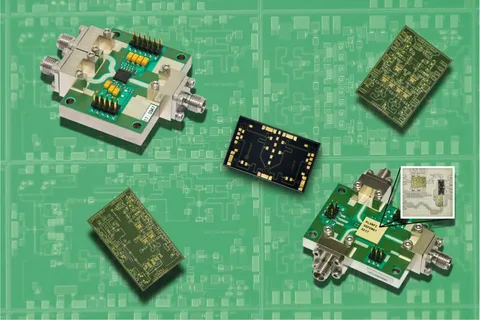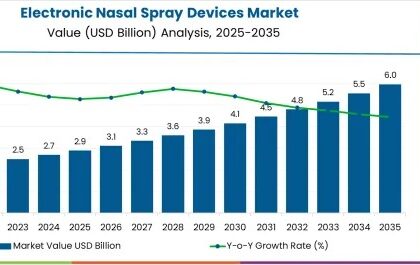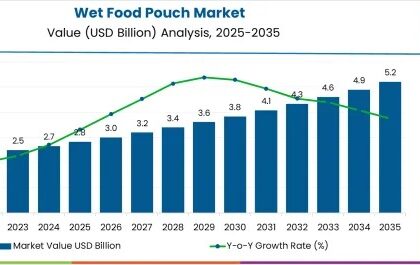The radio frequency integrated circuit (RFIC) market is likely to experience a dramatic expansion, as its estimated industry size is set to be around USD 27.7 billion in the year 2025 and go as far as USD 62.8 billion by 2035, which is an 8.3% CAGR over the forecast period. The wireless communication technology needs, 5Gs first delivery and IoT, as internal especial are among the prime reasons for the stepped-up usage across the line.
The Radio Frequency Integrated Circuit (RFIC) market is playing a foundational role in the age of wireless communication. From smartphones and smartwatches to satellite systems and 5G infrastructure, RFICs are the invisible engines enabling seamless connectivity. These compact yet powerful chips integrate multiple RF functions into a single package, streamlining design and optimizing performance across a range of applications.
As demand for faster data transmission, low-latency communication, and power-efficient wireless solutions continues to accelerate, RFICs are emerging as the cornerstone of innovation in both consumer and industrial electronics.
Get Ahead with Our Report: Request Your Sample Now!
Core to Wireless Innovation
RFICs are essential for transmitting and receiving radio signals in virtually every wireless device. They combine components such as amplifiers, mixers, oscillators, and filters into a miniaturized solution that enhances both signal strength and efficiency. This integration reduces size, cost, and power consumption—key factors in designing compact and high-performance electronics.
The widespread use of wireless standards like Bluetooth, Wi-Fi, LTE, and 5G has made RFICs indispensable in modern communication systems. Their role extends beyond connectivity to include applications in radar, navigation, and remote sensing technologies.
Driving Next-Gen Connectivity: 5G, IoT, and Beyond
The transition to 5G networks is a significant driver of RFIC innovation. 5G systems operate across a broader spectrum, including high-frequency millimeter wave bands that require advanced RF front-end modules. RFICs designed for 5G must support higher bandwidth, lower latency, and more complex modulation schemes, all while managing thermal and power constraints.
In parallel, the rise of the Internet of Things (IoT) is creating new demand for low-power RFICs that can maintain reliable communication in constrained environments. Smart home devices, wearables, connected cars, and industrial sensors all rely on RFICs for secure and efficient wireless performance.
Miniaturization and Integration in Consumer Electronics
As devices become smaller and more feature-rich, RFICs must deliver enhanced functionality within ever-shrinking footprints. Advances in semiconductor manufacturing—such as silicon-germanium (SiGe) and compound semiconductors like gallium arsenide (GaAs) and gallium nitride (GaN)—are enabling high-frequency performance with minimal energy loss.
System-on-chip (SoC) designs that integrate RFICs with processors, memory, and sensors are becoming more prevalent, particularly in mobile and wearable technology. This integration not only simplifies board design but also improves system reliability and energy efficiency.
Exhaustive Market Report: A Complete Study
Automotive and Aerospace Applications Expand the Horizon
Beyond consumer electronics, RFICs are gaining prominence in automotive radar, vehicle-to-everything (V2X) communication, and advanced driver assistance systems (ADAS). These applications require robust RFICs capable of operating in harsh environments and at high frequencies.
In aerospace and defense, RFICs are used in satellite communications, electronic warfare systems, and navigation. Their ability to operate across broad frequency ranges with high precision makes them vital for mission-critical communication and surveillance tasks.
Customization and Design Flexibility
Manufacturers are increasingly focusing on application-specific RFICs to meet the unique requirements of different industries. Custom RFICs offer optimized performance, better integration with existing architectures, and improved signal fidelity.
Simulation tools and RF design software are accelerating the development process, allowing engineers to test and refine designs in virtual environments before prototyping. This flexibility shortens time to market and enables rapid adaptation to emerging technologies.
Challenges and the Path Forward
Despite their advantages, RFICs face challenges related to heat dissipation, signal interference, and complexity at higher frequencies. As data rates increase and applications expand into mmWave and terahertz domains, maintaining signal integrity becomes more difficult.
Ongoing research into new materials, packaging methods, and advanced circuit topologies is essential to overcome these challenges. Innovations such as 3D packaging, advanced thermal management, and AI-assisted RF tuning are likely to play a key role in the next wave of RFIC development.
The Invisible Force Behind the Connected World
The Radio Frequency Integrated Circuit market is not just supporting the growth of wireless technology—it’s enabling it. By making communication faster, devices smaller, and systems smarter, RFICs are shaping a world where connectivity is seamless and ubiquitous.
As digital transformation deepens across industries, RFICs will continue to power the systems that keep people, machines, and environments interconnected. In a future defined by wireless everything, RFICs are the invisible force tuning the world into the next generation of connectivity.
Catapult Your Strategy: Secure Key Insights with Our Report Checkout!
About Future Market Insights (FMI)
Future Market Insights, Inc. (ESOMAR certified, recipient of the Stevie Award, and a member of the Greater New York Chamber of Commerce) offers profound insights into the driving factors that are boosting demand in the market. FMI stands as the leading global provider of market intelligence, advisory services, consulting, and events for the Packaging, Food and Beverage, Consumer Technology, Healthcare, Industrial, and Chemicals markets. With a vast team of 400 analysts worldwide, FMI provides global, regional, and local expertise on diverse domains and industry trends across more than 110 countries.
Contact Us:
Future Market Insights Inc.
Christiana Corporate, 200 Continental Drive,
Suite 401, Newark, Delaware – 19713, USA
T: +1-845-579-5705
For Sales Enquiries: sales@futuremarketinsights.com
Website: https://www.futuremarketinsights.com
LinkedIn| Twitter| Blogs | YouTube





